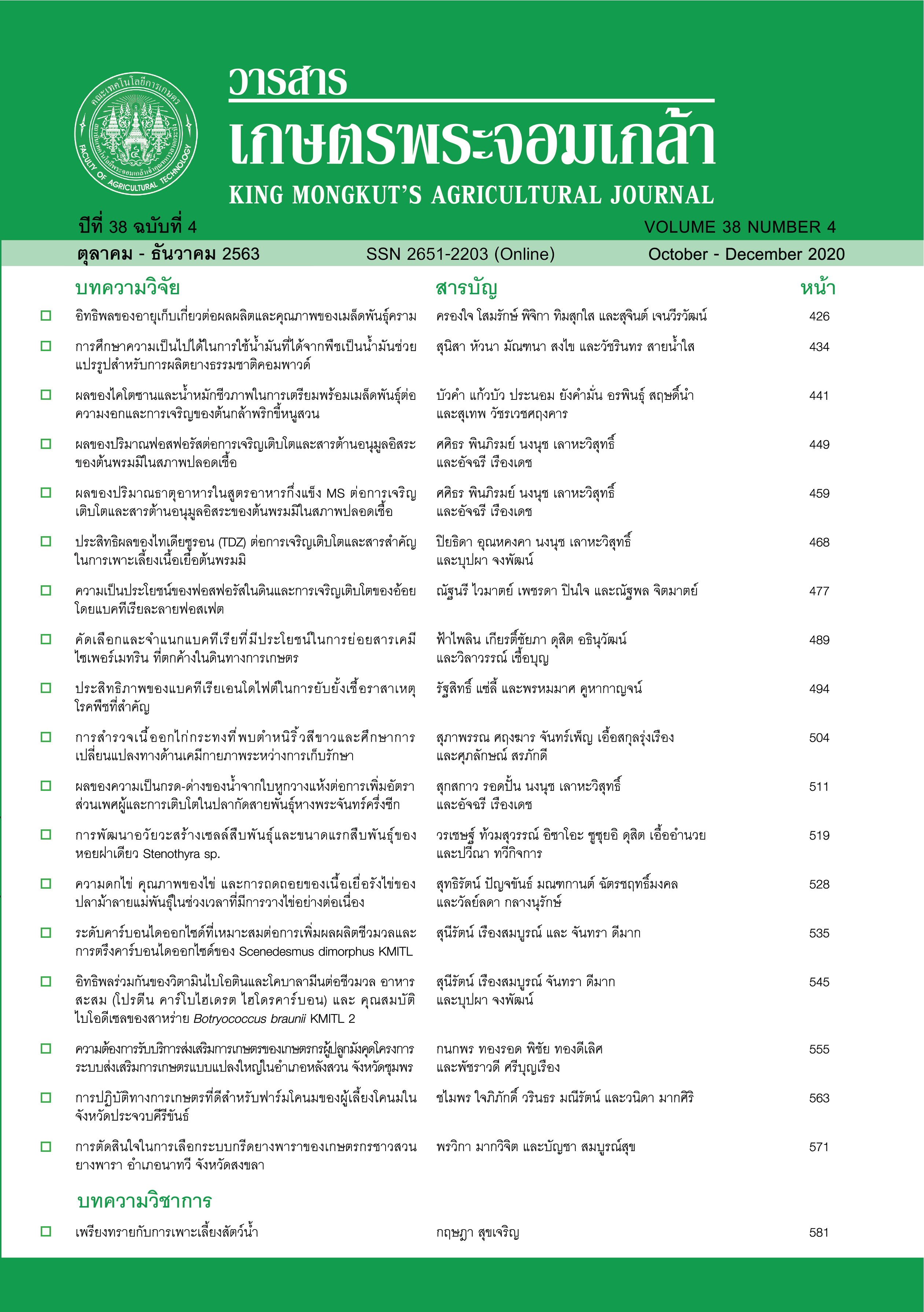ระดับคาร์บอนไดออกไซด์ที่เหมาะสมต่อการเพิ่มผลผลิตชีวมวลและการตรึงคาร์บอนไดออกไซด์ ของ Scenedesmus dimorphus KMITL
Main Article Content
บทคัดย่อ
การศึกษาระดับที่เหมาะสมของคาร์บอนไดออกไซด์ในการเพิ่มผลผลิตชีวมวล องค์ประกอบทางชีวเคมี และการตรึงคาร์บอนไดออกไซด์ของสาหร่ายสีเขียวขนาดเล็ก Scenedesmus dimorphus KMITL โดยผันแปรระดับคาร์บอนไดออกไซด์ที่ 0.03, 2.50, 5.00 และ 7.50 เปอร์เซ็นต์ เพาะเลี้ยงสาหร่ายในอาหารสูตร Chlorella ปลอดเชื้อในห้องปฏิบัติการเป็นเวลา 18 วัน ผลการศึกษาพบว่าที่ระดับการเสริมคาร์บอนไดออกไซด์ในอาหาร 5.00 เปอร์เซ็นต์ สาหร่ายมีชีวมวล คลอโรฟิลล์-เอ โปรตีน และ คาร์บอนในเซลล์ สูงสุดเท่ากับ 1.15±0.03 กรัมต่อลิตร 2.48±0.05 มิลลิกรัมต่อลิตร 305.73±28.65 มิลลิกรัมต่อกรัม และ 33.83±0.56 เปอร์เซ็นต์ ตามลำดับ ส่วนปริมาณแคโรทีนอยด์พบสูงสุด 2.33±0.35 ไมโครกรัมต่อลิตร ที่ระดับคาร์บอนไดออกไซด์ 0.03 เปอร์เซ็นต์ ปริมาณคาร์โบไฮเดรตพบสูงสุด 206.31±18.82 มิลลิกรัมต่อกรัม ที่ระดับคาร์บอนไดออกไซด์ 7.50 เปอร์เซ็นต์ สาหร่ายที่ได้รับคาร์บอนไดออกไซด์ 5.00 เปอร์เซ็นต์ มีความสามารถในการตรึงคาร์บอนไดออกไซด์ได้สูงที่สุด โดยมีการตรึงคาร์บอนไดออกไซด์ 1.24±0.03 กรัมต่อกรัม หรือ 1.43±0.03 กรัมต่อลิตร, อัตราการตรึงคาร์บอนไดออกไซด์ 50.95±3.98 กิโลกรัมต่อลูกบาศก์เมตรต่อปี สาหร่ายชนิดนี้มีกรดไขมัน C16:0 เป็นองค์ประกอบหลัก โดยมีค่าอยู่ในช่วง 19.85-57.91 เปอร์เซ็นต์ รองลงมาคือ C18:0 มีค่าอยู่ในช่วง 11.33-20.53 เปอร์เซ็นต์ และ C18:3n3 มีค่าอยู่ในช่วง 9.45-22.44 เปอร์เซ็นต์ ดังนั้นระดับคาร์บอนไดออกไซด์ที่ 5.00 เปอร์เซ็นต์ คือระดับที่เหมาะสมที่สุดในการเพิ่มผลผลิตของสาหร่ายสายพันธุ์นี้ และสาหร่ายนี้ยังมีความสามารถในการตรึงคาร์บอนไดออกไซด์ได้สูง ดังนั้น S. dimorphus KMITL จึงเป็นทางเลือกในการนำไปใช้เป็นตัวดูดซับคาร์บอนไดออกไซด์ที่ปล่อยจากโรงงานอุตสาหกรรมได้
Article Details
วารสารเกษตรพระจอมเกล้า
เอกสารอ้างอิง
สุนีรัตน์ เรืองสมบูรณ์ และจันทรา ดีมาก. 2561. ผลของอัตราส่วนไนโตรเจนต่อเหล็ก ต่อการเจริญและการผลิตไขมันของสาหร่ายสีเขียว Scenedesmus dimorphus. วารสารเกษตรพระจอมเกล้า 36: 77-86.
Aburail, N., Sumida, D., and Abe, K. 2015. Effect of light level and salinity on the composition and accumulation of free and ester-type carotenoids in the aerial microalga Scenedesmus sp. (Chlorophyceae). Algal Research 8: 30-36.
Becker, E. W. 1994. Microalgae Biotechnology and Microbiology. Great Britain: Cambridge University Press.
Bligh, E. G., and Dyer, W. J. 1959. A rapid method of total lipid extraction and purification. Canadian Journal of Biochemistry and Physiology 37: 911-917.
Borowitzka, M. A. 2010. Carotenoid production using microorganisms, pp. 225-240. In Single cell oils. Microbial and Algal Oils,
Z. Cohen, and C. Ratledge, eds. Urbana: AOCS Press.
Borowitzka, M. A. 2013. High-value products from microalgae-their development and commercialization. Journal of Applied Phycology 25: 743-756.
DuBois, M., Gilles, K. A., Hamilton, J. K., Rebers, P. A., and Smith, F. 1956. Colorimetric method for determination of sugars and related substances. Analytical Chemistry 28: 350-356.
Dufosse, L., Galaup, P., Yaron, A., Arad, S. M., Blanc, P., Chidambara Murthy, K. N., and Pavishankar, G. A. 2005. Microorganisms and microalgae as sources of pigments for food use: a scientific oddity or and industrial reality?. Trends in Food Science and Technology 16: 389-406.
Farias Silva, C. E., and Bertucco, A. 2016. Bioethanol from microalgae and cyanobacteria: A review and technological outlook.
Process Biochemistry 51: 1833-1842.
Ge, Y., Liu, J., and Tian, G. 2011. Growth characteristics of Botryococcus braunii 765 under high CO2 concentration in photobioreactor. Bioresource Technology 102: 130-134.
Ho, S. H., Chen, C. Y., and Chang, J. S. 2012. Effect of light intensity and nitrogen starvation on CO2 fixation and lipid/carbohydrate production of an indigenous microalga Scenedesmus obliquus CNW-N. Bioresource Technology 113: 244-252.
Jacob-Lopes, E., Scoparo, C. H. G., Lacerda, L. M. C. F., and Franco, T. T. 2009. Effect of light cycles (night/day) on CO2 fixation and biomass production by micro-algae in photobioreactors. Chemical Engineering and Processing 48: 306-310.
Kishimoto, M., Okakura, T., Nagashima, H., Minowa, T., Yokoyama, S., and Yamabe, K. 1994. CO2 fixation and oil production using micro-algae. Journal of Fermentation and Bioengineering 78: 479-482.
Lowry, O. H., Rosenbrough, N. J., Farr, A. L. and Randall, R. J. 1951. Protein measurement which the folin phenol reagent. Journal of Biological Chemistry 193: 265-275.
Morais, M. G., and Costa, J. A. V. 2007. Carbon dioxide fiation by Chlorella kessleri, C. vulgaris, Scenedesmus obliquus and Spirulina sp. cultivated in flasks and vertical tubular photobioreactors. Biotechnology Letters 29: 1349-1352.
Murakami, M., and Ikenouchi, M. 1997. The biological CO2 fixation and utilization project by RITE-Screening and breeding of microalgae with high capability in fixing CO2. Energy Conversion Management 38: S493-S497.
National Oceanic and Atmospheric Administration. 2018. Trends in atmospheric carbon dioxide. Source: https://www.esrl.noaa.gov/gmd/ccgg/trends/global.html#global (15 May 2019).
Ostgaard, K., Indergaard, M., Markussen, S., Knutsen, S. H., and Jensen, A. 1993. Carbohydrate degradation and methane production during fermentation of Laminaria saccharina (Laminariales, Phaeophyceae). Journal of Applied Phycology 5: 333-342.
Pooja, K., and Himabindu, V. 2012. CO2 removal from industrial flue gas using Botrycoccus branii for simultaneous lipid production. International Journal of Science and Research 3: 366-373.
Qin, S., Liu, G. X., and Hu, Z. Y. 2008. The accumulation and metabolism of astaxanthin in Scenedesmus obliquus (Chlorophyceae). Process Biochemistry 43: 795-802.
Ruangsomboon, S., Ganmanee, M., and Choochote, S. 2013. Effects of different nitrogen, phosphorus, and iron concentrations and salinity on lipid production in newly isolated strain of the tropical green microalga, Scenedesmus dimorphus KMITL.
Journal of Applied Phycology 25: 867-874.
Ruangsomboon, S., Choochote, S., Thaweekijakarn, P., and Aue-umneoy, D. 2012. Nitrogen and Phosphorus removal from wastewater by green microalga, Scenedesmus dimorphus. In Proceeding of the 2nd Asia-Oceania algae innovation summit: algae for sustainable development. 3-5 September 2012. Bangkok. Thailand.
Sydney, E. B., Sturm, W., Carvalho, J. C., Thomax-Soccol, V., Larroche, C., Pandey, A., and Soccol, C. R. 2010. Potential carbon dioxide fixation by industrially important microalgae. Bioresource technology 101: 5892-5896.
Tang, D., Han, W., Li, P., Miao, X., and Zhong, J. 2011. CO2 biofixation and fatty acid composition of Scenedesmus obliquus and Chlorella pyrenoidosa in response to different CO2 levels. Bioresource Technology 102: 3071–3076.
Toledo-Cervantes, A., Morales, M., Novelo, E., and Revah, S. 2013. Carbon dioxide fixation and lipid storage by Scenedesmus obtusiusculus. Bioresource Technology 130: 652-658.
Vonshak, A., and Maske, H. 1982. Algae: growth techniques and biomass production. In Techniques in Bioproductivity and Photosynthesis, J. Coombs, and D.O. Hall, eds. pp. 66-77. Oxford: Pergamon Press.
Xin, L., Hong-Ying, H., and Jia, Y. 2010a. Lipid accumulation and nutrients removal properties in secondary effluent of a newly-isolated freshwater microalga Scenedesmus sp. LX1. New Biotechnology 27: 59-63.
Xin, L., Hong-ying, H., Ke, G., and Ying-Xue, S. 2010b. Effects of different nitrogen and phosphorus concentrations on the growth, nutrient uptake, and lipid accumulation of a freshwater microalga Scenedesmus sp. Bioresource Technology 101: 5494-5500.
Yoshimura, T., Okada, S., and Honda, M. 2013. Culture of the hydrocarbon producing microalga Botryococcus braunii strain Showa: optimal CO2, salinity, temperature, and irradiance conditions. Bioresource Technology 133: 232-239.


